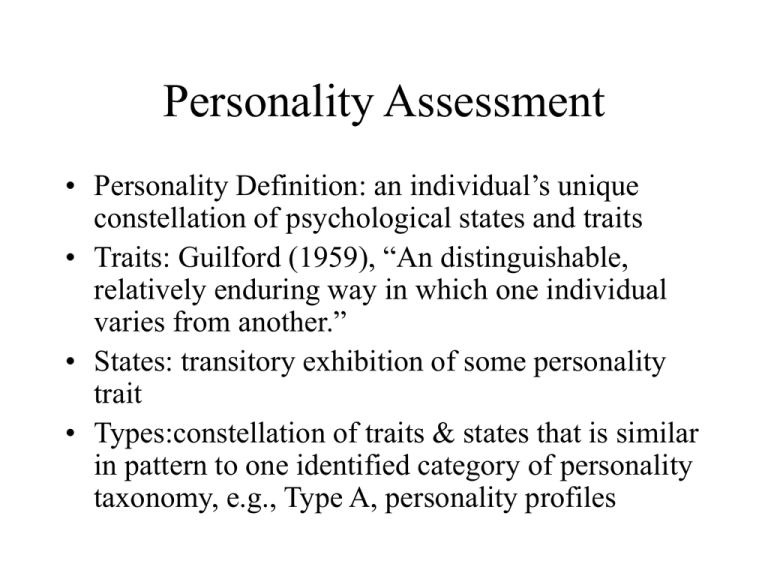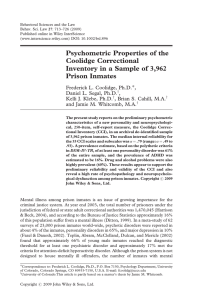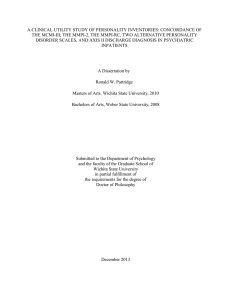Personality Assessment Methods & Projective Techniques
advertisement

Personality Assessment • Personality Definition: an individual’s unique constellation of psychological states and traits • Traits: Guilford (1959), “An distinguishable, relatively enduring way in which one individual varies from another.” • States: transitory exhibition of some personality trait • Types:constellation of traits & states that is similar in pattern to one identified category of personality taxonomy, e.g., Type A, personality profiles Basic Characteristics of Personality Assessment Methods • Personality v. IQ & Achievement tests – Typical v. maximum performance tests – Stability of constructs of interest • Degree of inference in assessment methods – Behavioral v. “traditional” v. projective • Interpretation approaches – Clinical v. actuarial Methods of Developing Assessment Methods • Logic/Reason – Face validity, content-oriented approach • E.g., DSM questionnaires • Theory – Questions reflect theory about personality & human behavior • E.g., Self-Directed Search, EPPS Methods of Developing Assessment Methods (cont.) • Data Reduction methods – Factor analysis to place items to scales • E.g., Cattell & 16PF, Children’s Personality Questionnaire, NEO PI-R (Big 5, Neuroticism, Extraversion, Openness, Agreeableness, Conscientiousness) • Empirical Criterion Keying – Can items/scales distinguish among groups? • E.g., MMPI MMPI Overview • Psychiatric patients v. visitors • 567 true-false items • 10 clinical scales that could differentiate the groups • “validity” scales • Several “research”/content scales developed over the years MMPA-2 • Items rewritten – Eliminated “objectionable” wording • Added items – Drug abuse, Type A, attitudes toward work • 3 new validity scales • New content scales, clinical scales the same • Larger & more representative normative sample Projective Assessment • Psychodynamic origination • Projective hypothesis – When confronted with ambiguous stimuli subjects will create structure which reveals information about their personalities, needs, drives, etc. Projectives (cont.) • Defining characteristics – Lack of stimulus structure – Multiplicity of responses permitted – Absence of right or wrong answers • Assumptions – Because they are ambiguous, they elicit more meaningful information; – They are less susceptible to faking – Reveal more unconscious aspects of personality Examples of projectives • Rorschach – 10 ink blots – Exner comprehensive scoring system • Free association and inquiry phases • What are characteristics of response? – E.g., location, popular responses, perseveration Storytelling/Apperception tests • Thematic Apperception Test (TAT) – Murray’s Needs-Press theory – What’s happening in the picture? What events led up to the scene? What will happen next? What are the people’s thoughts, feelings, etc. – Hero, Needs, press, outcomes, themes • Children’s Apperception Test, Robert’s Apperception Test • Modifications for individuals of differing ethnic backgrouns Projective drawings • • • • Overall appraisal + “sign” approach Draw a Person House-Tree-Person Kinetic Family Drawing Evaluation of Projectives • Are they tests? – Can they be held to psychometric standards? • Assumptions have not really held up. • Can be influenced by situational variables. Stimuli not as ambiguous as assumed. • Psychometrics not been demonstrated despite years of study.






